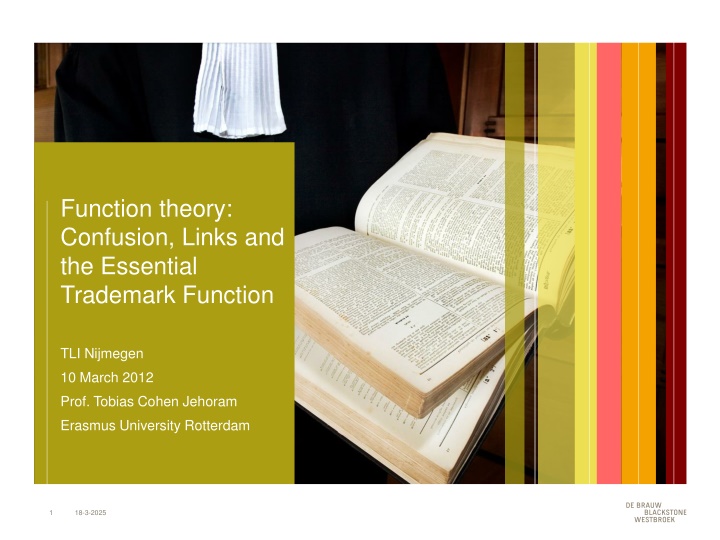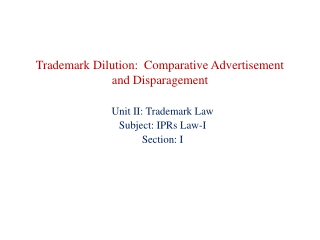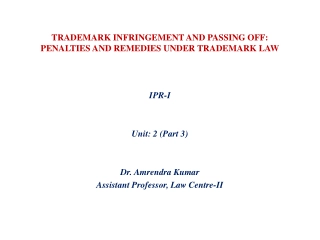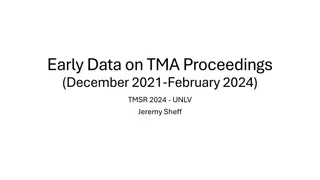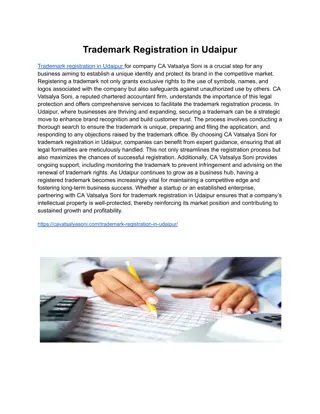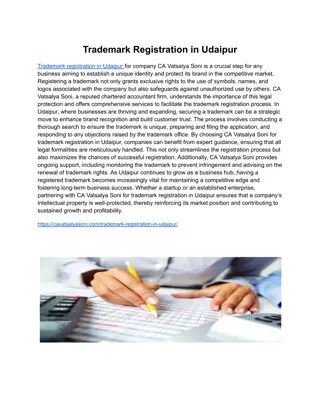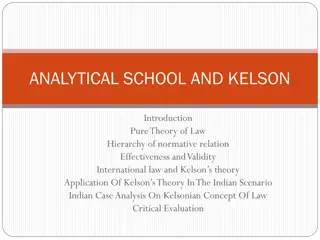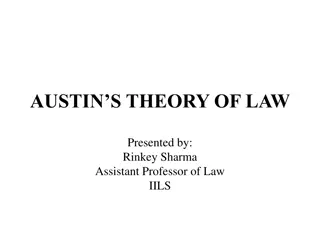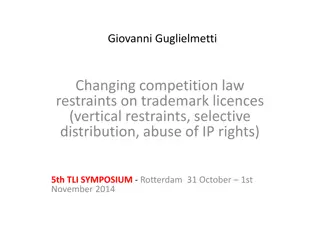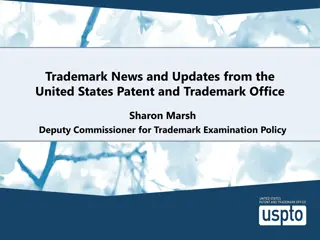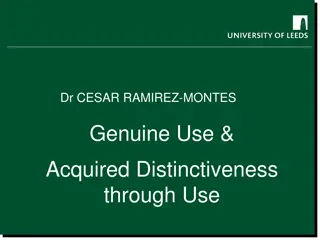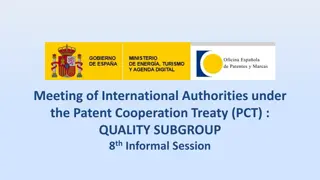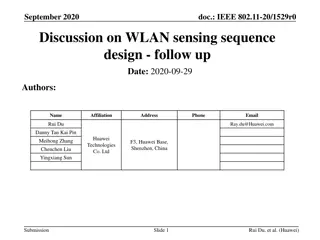Function Theory in Trademark Law Analysis
Explore the function theory in trademark law, its historical development, and practical implications. Delve into the protected functions, effects under TMD, and the CoJ's interpretation. Understand the evolution of the theory and its impact on trademark applications.
Download Presentation

Please find below an Image/Link to download the presentation.
The content on the website is provided AS IS for your information and personal use only. It may not be sold, licensed, or shared on other websites without obtaining consent from the author.If you encounter any issues during the download, it is possible that the publisher has removed the file from their server.
You are allowed to download the files provided on this website for personal or commercial use, subject to the condition that they are used lawfully. All files are the property of their respective owners.
The content on the website is provided AS IS for your information and personal use only. It may not be sold, licensed, or shared on other websites without obtaining consent from the author.
E N D
Presentation Transcript
Function theory: Confusion, Links and the Essential Trademark Function TLI Nijmegen 10 March 2012 Prof. Tobias Cohen Jehoram Erasmus University Rotterdam 1 18-3-2025
Overview Brief history Factual and legal background The functions according to the CoJ What do the protected functions cover? Which function is relevant when? Effects under 5(1)(a) TMD Effects under 5(1)(b) TMD Relationship to treaty obligations 2 18-3-2025
Function theory No basis in the Directive or Regulation 100% created, interpreted and defined by CoJ Important to see where it, and where the CoJ were coming from In order to understand its meaning And the way the CoJ is thinking 3 18-3-2025
History of the Function Theory CoJ H lterhoff/Freiesleben 14 May 2002 - It is common ground that, in such a situation, the use of the trade mark is a use in the course of trade in relation to products identical with or similar to those for which the trade mark was registered (sic) - no question of the trade mark used being perceived as a sign indicative of the undertaking of origin. - the use of the trade mark does not infringe any of the interests which Article 5(1) is intended to protect. - Mistake? But of course followed in Arsenal/reed, Budweiser, Opel/Autec, Google France, Interflora First only in relation to 5(1)TMD, later also 5(2) TMD (L Or al/Bellure) Where does the theory come from? 4 18-3-2025
Practical problem due to extending scope of harmonization CoJ wanted and wants to extend the scope of harmonized trademark law as far as possible So that it comes within its reach; cannot rule on art 5(5) TMD 5(1)(a) TMD once written for cases of counterfeit, rip offs and the basic monopoly CoJ extended 5(1)(a) TMD application to - Comparative advertising (O2) - Use as a reference in general (Opel/Autec) - Any affixing to the product (Budweiser) - Tradename use when the public sees a link between TM and product/service (after Robeco/Robelco: Budvar 245/02 and C line) - Any use that directly or indirectly promotes sale of goods/services But very often (of course) allowed use, while all criteria of the article have been met CoJ needs an escape 18-3-2025 5
Trademark law as part of competition law There are no trademark lawyers on the bench at the CoJ There ARE many competition lawyers on the bench And of course trademark law constitutes an essential element in the system of undistorted competition (Loendersloot) Like competition law does too The effect we see in cases like Interflora, where fair competition becomes a due cause Or L Or al/Bellure, where fair competition is also the rationale (stemming from Advertising Dir) The CoJ is pulling TM law into the field of competition law 6 18-3-2025
Rule of Reason Doctrine Rule of Reason doctrine US Supreme Court in 1911 decision Standard Oil Co. of NJ v. U.S., 221 U.S. 1 Interpretation of the Sherman Act (anti-trust law) only combinations and contracts unreasonably restraining trade are subject to actions under the anti-trust laws, and possession of monopoly power is not inherently illegal. Further refined in case law Crossed the Atlantic Ocean on 20 February 1979: Cassis de Dijon (Rewe- Zentral AG v. Bundesmonopolverwaltung Branntwein, 120/78) are the effects of the legislation (on the free movement of goods) justified in light of the legislation's stated goals? CoJ indeed now considers the goals of TM legislation: protected functions 7 18-3-2025
Rule of Reason Important: rather a limitation to the rights/application of the law than a positive requirement for infringement Effect on the burden of proof Is it rather a justification theory on which the defendant can rely, than a function theory in the sense that the TM holder would have to prove a TM function being affected? But: It follows from that case-law that the proprietor of the trade mark cannot oppose the use of a sign identical with the mark if that use is not liable to cause detriment to any of the functions of that mark (Google) 8 18-3-2025
Functions according to the CoJ CoJ identifies different functions (was always plural: Ideal Standard) Functions identified by the CoJ to date (but counting?) - Origin function (essential function, mentioned in law: cons 10) - Identification function (art 1 TMD: able to distinguish) - Quality (guarantee) function - Advertising function (communication function) - Investment function - Goodwill function (?) 9 18-3-2025
What do the protected functions cover? Origin (guarantee) function - Goods/services might come from the same or commercially linked undertakings (Cannon/Canon, Lloyd/Loints) - But in online environment (AdWords): adversely affected if the advertisement does not enable reasonably well- informed and reasonably observant internet users, or enables them only with difficulty, to ascertain whether the goods or services referred to by the advertisement originate from the proprietor of the trade mark or an undertaking economically connected to it or, on the contrary, originate from a third party is vague to such an extent on the origin of the goods or services at issue that reasonably well-informed and reasonably observant internet users are unable to determine, on the basis of the advertising link and the commercial message attached thereto, whether the advertiser is a third party vis- -vis the proprietor of the trade mark or whether, on the contrary, it is economically linked to that proprietor (Google France; art 6 e-Commerce Dir) 10 18-3-2025
What do the protected functions cover? Identification function - Ability to attract and retain customers (already in Loendersloot) - detriment to the distinctive character of the trade mark by contributing to turning it into a generic term (Interflora) Quality (guarantee) function - Symbolises qualities associated by consumers with goods/services and guarantees they live up to the expectations (AG Jacobs in Evora/Dior) - A guarantee that products have been manufactured under the control of a single undertaking/responsibility for quality (Ideal Standard, Loendersloot) Advertising function - Inform and persuade consumers (Google France) - Instrument of commercial strategy (Google France) - Online: not affected if ends up high in natural search results (Google France) 11 18-3-2025
What do the protected functions cover? Investment function - to acquire or preserve a reputation capable of attracting consumers and retaining their loyalty (Interflora) Adversely affected when substantially interferes with use to acquire or preserve a reputation capable of attracting consumers and retaining their loyalty jeopardises the maintenance of a reputation capable of attracting consumers and retaining their loyalty - Overlap with advertising function, but also covers other commercial techniques Goodwill function? - Detracting from the allure and prestigious image (Evora/Dior) - Protection against free riding (L Or al/Bellure) - Protecting image, reputation, attractiveness, built up goodwill? 12 18-3-2025
Which is relevant where? Which one is relevant depends on the article in question 5(1)(a) TMD: all functions (L Or al/Bellure, Interflora) - But with AdWords: only origin function and advertising function (why?) 5(1)(b) TMD: origin function (Bergspechte, implicit) 5(2) TMD: - Origin function - Advertising function - Quality (guarantee) function - Investment function - implicit goodwill function? 13 18-3-2025
What is necessary under 5(1)(a) TMD? 1) Use of a sign by third party 2) in the course of trade 3) without consent of the TM holder 4) identical to the TM 5) in relation to goods or services for which TM is registered: CoJ here takes the functional approach - In any case of referential use (comparative advertising, offering alternative) condition will usually be met 6) must affect or be liable to affect ANY of the functions of the mark - Odd to some extent, as 5(1) TMD seems to focus on origin related function(s) see also cons 10- and only 5(2) on goodwill related functions - But explicit in Interflora - However, in practice we see the CoJ forget some functions An oddity: which TM function is affected in case of parallel trade from outside the EEA? 14 18-3-2025
Art 5(1)(a) TMD online Under 5(1)(a) TMD ALL functions are relevant (L Or al/Bellure, Interflora) But when it comes to AdWords suddenly all functions evapoarte, except origin function and advertising function (?) Advertising function never harmed (?) with reasoning that leaves to be desired Result from deductions: only origin function relevant under 5(1)(a) TMD test. But the specifics of the origin function to be affected (unclear or difficult where goods originate from, unclear or difficult to establish relationship advertiser-TM proprietor) suggest a likelihood of confusion threshold 15 18-3-2025
Art 5(1)(a) TMD vs Art 16 TRIPs Art 16 par 1 TRIPs - Protection against risk of confusion - In case of the use of an identical sign for identical goods or services, a likelihood of confusion shall be presumed - Reflected in art 10 cons TMD: absolute protection Requiring more (detriment to a TM function) is a violation of TRIPs treaty obligations And this happens in cases like Google, where the CoJ requires the origin function to be affected (other would not be relevant) Maybe an escape in the presumption of LOC But then at least burden of proof of no detriment, on defendant 16 18-3-2025
Art 5(1)(b) TMD Due to required risk of confusion: always detriment to origin function But not only when the relevant public believes that the goods or servoces come from the same or commercially linked undertakings Also the same requirements as under 5(1)(a) TMD, as to the origin function being affected, apply (Bergspechte) Applying the same test under 5(1)(a) TMD and 5(1)(b) TMD seems certainly in violation of art 16 TRIPs, that clearly distinguishes the two The CoJ seems to be on the wrong track, either on 5(1)(a) TMD or on 5(1)(b) TMD, or on both 17 18-3-2025
Thank you! Prof. Tobias Cohen Jehoram De Brauw Blackstone Westbroek / Erasmus University Rotterdam Tobias.cohen jehoram@debrauw.com 18 18-3-2025
19 18-3-2025
